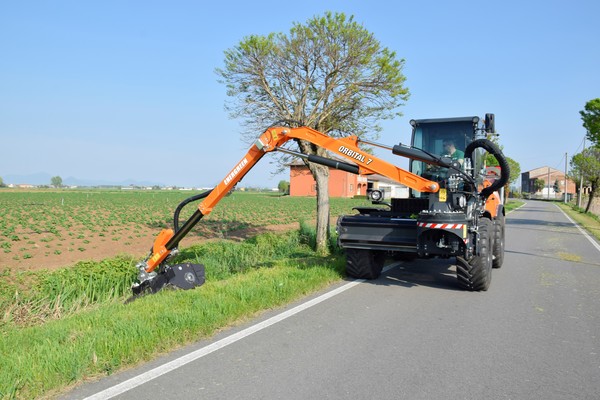
Self-propelled brushcutters, machines for heavy duty operations
Conventional mowing machines cannot be used for cutting dense grass over one metre, tall and for shredding low woody ground cover with a diameter of more than 50-60 mm, but self-propelled brushcutters can do the job. Various types are available on the market
There are various areas covered by tall herbaceous vegetation and/or shrub vegetation, such as those found in undergrowth, on escarpments, along river banks, etc.. These are areas whose vegetation, especially in periods of drought and high temperatures, can pose a serious risk for the start and spread of fires. Apart from aesthetic aspects, maintenance work in these areas is indispensable. Normal mowers cannot be used when herbaceous vegetation exceeds certain heights and/or the stem exceeds certain diameters. Lawn mowers with helical blades reach their limit when the height of fine grass exceeds 15 cm; those with rotary blades have an upper limit that does not, however, go beyond 25-30 cm, especially in high density and even shrub vegetation with a diameter greater than 4-5 mm.
In these situations, it is necessary to use machines that are suitable for the purpose, i.e. capable of cutting dense grass up to heights of even more than 1 metre and shredding low woody cover with a diameter of even more than 50-60 mm. This type of operation is typical of self-propelled brushcutters. These can be with a driver on the ground, with a driver on board, or remote-controlled, not forgetting the brush cutter arms.
Ground-driven brushcutters
The brush cutter of this machine category can be wire-mounted, with a rotating blade or with a horizontal rotor on which blades or hammers are mounted. The choice is linked to the type of vegetation being processed. The apparatus is mounted on a machine with two pneumatic drive wheels driven by an operator on the ground. An automatic brake acts on the rotor when the engagement lever is released, thus ensuring the driver’s safety. These machines are used for cutting undergrowth, on country lanes, roundabouts, roadsides and embankments.
In wire models, the cutting width is 40-80 cm, with adjustable height from 1.5 to 6 cm, and maximum forward speed of 2.5 km/h. The endothermic engine, usually single-cylinder, has a power range between 2.5 and 4 kW. Forced lubrication of the engine allows operation on slopes, vertical and diagonal, of up to 30°. Due to the use on sloping areas, the guide handles, in addition to being adjustable in height, can be tilted to the right or left. The cutter deck is equipped with a side guard.
The vertical blade or hammer rotor version mounted on a horizontal rotor is preferred when working on dense shrub vegetation consisting of brambles and other shrubs. In difficult situations, hydrostatic transmission models are preferred, allowing the speed to be adjusted continuously. The engine power is between 3.5 and 5 kW. The cutting width is 50-100 cm, while the height is adjustable between 4 and 12 cm. The maximum speed is 4.5 km/h. The handlebars on these models are also height-adjustable and can be tilted to the right or left. In line with current trends related to the ecological transition, there is a move towards zero-emission vehicles, so all-electric versions are being presented.
Ride-on and remote-controlled brushcutters
Ride-on brushcutters have two or four-wheel drive, although there is no shortage of tracked versions. Thanks to their low centre of gravity and differential lock that prevents the wheels from turning at different speeds, they can be used on slopes of 20° up to 45°. The cutting device is either a rotating blade or floating blades on a horizontal rotor. The second solution addresses situations with shrubs and/or obstacles in the ground, such as pebbles, stumps, or others. In some models, the cutting device casing is also floating in order to compensate for ground unevenness. The working width varies from 80 to 120 cm, while the cutting height is adjustable from a few millimetres to 15 cm. This allows the machine to be used for cutting grass and shrubs at a defined height. The shrub diameter compatible with the machine's capacity also depends on the type of cutting device. As a guide, the cutting capacity can be said to be up to 60 mm and even more. The forward speed is dependent on the operating conditions; the maximum speed is approximately 12 km/h. Ride-on brushcutters are powered by two-cylinder endothermic engines. Power can exceed 20-25 kW. The transmission is mechanical or hydrostatic. There are also fully electric machines on the market. Electric drive is a rapidly developing sector that is becoming increasingly popular for different types of green machinery.
There are also models available that, in addition to being manually driven, can be radio-controlled or only remote-controlled, to allow work in particularly difficult conditions and on steep slopes. The remote-controlled models are basically brush-cutters capable of working on high grass and in difficult access conditions. The 4-wheel steering models are able to rotate around their own axis. Thanks to their very low centre of gravity, they can operate on slopes of up to 40° to 45°. The working width is up to 120 cm and the cutting height is between 9 and 12 cm. The transmission is hydrostatic and engine power is around 20 kW. Radio-controlled brushcutters with rubber tracks are also produced, suitable for working on very uneven terrain and slopes of up to 60°.
Brushcutter arms
The characteristic of brushcutter arms is the considerable reach in relation to the position of the tractor's driving force, with the headstock being able to operate not only horizontally and vertically, but also at an angle. For these reasons they are mainly used for cutting roadsides, canal banks and ditches, as well as for clearing tree crowns. The working section consists of a rotor on which blades or hammers are hinged. The maximum working width generally does not exceed 2 metres and the drive is purely hydraulic. Due to the forces involved, it is important that the implement's independent hydraulic system is adequately sized. Coupling to the tractor is generally via the three-point linkage of the lift. For reasons of stability, the mass and track width of the tractor to which the cutter arm is coupled count more than the engine power. Smaller models, with a maximum horizontal reach of 3-3.5 metres and a vertical reach of 3.5-4 metres, are coupled to tractors with an engine power of 25-35 kW, a mass of over 1,700-1,800 kg and a track width of around 1.5 metres. The larger ones, with a maximum horizontal and vertical reach of 6 metres and more, are coupled to tractors with an engine power of around 100 kW, a mass of no less than 4,000 kg and a track width of around 2.30 metres. To balance the destabilising moment created by the outreach of the header, tractors are often additionally ballasted. Models with electric drive are also available for this category of brushcutters.








